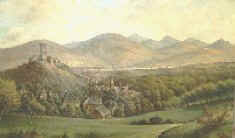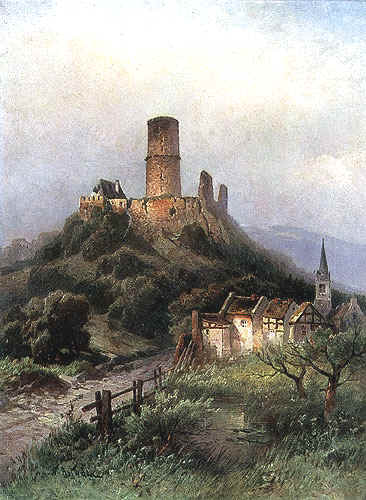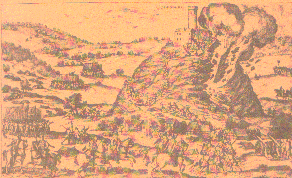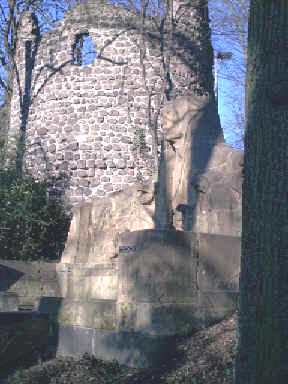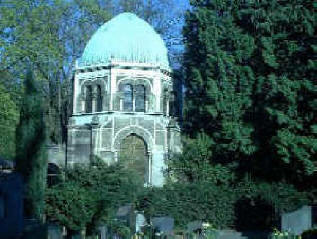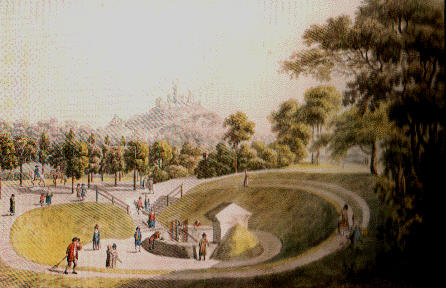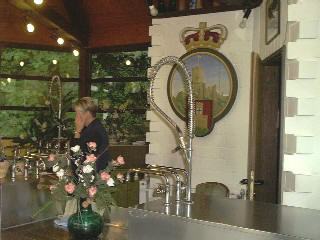|
|
|
Dear Visitor, it is our pleasure to welcome you to a virtual tour through Bad Godesberg. |
|
|
The Godesburg is
the old castle. Its donjon, or main tower, of almost 100 ft (32 meters) offers a wide view over Bonn, over the green borough
of Bad Godesberg and the Rhine valley. You find Bad Godesberg at the southern end of the
Cologne plain between the Seven Mountains and the foothills of the Eifel Mountains; its eventful history still shows traces.
Bad Godesberg once was the spa of of the archbishops and prince electors of
Cologne as well as of their nobility-in-court; later, around 1900, it became a popular retirement town and spa, after World
War II it served as home for many diplomatic missions (to the capital of the Federal Republic). Today, Bad Godesberg
presents itself as the borough of Bonn with the most beautiful setting; its landscape with parks and its extensive
pedestrian zone, indeed, invite to a walking tour. We start our virtual tour from the Godesburg, the northernmost castle built
on a mountain in the Rhine valley.
Archbishop Dietrich I of Hengebach
conducted the cornerstone ceremony for the Godesburg Castle in 1210. However, the first five floors of the donjon were not
completed until 1244 by Archbishop Konrad von Staden. From 1332 until 1349, through orders from Archbishop Walram von Jülich
the fortifications were expanded; half its size was added to the donjon to bring it to its current 32 meters, and its thick
walls (of 3 meters) were to house the archives of the archdiocese.
|
|
|
|
Thereupon, Duke Ferdinand of Bavaria (the brother of the new archbishop) laid
a long siege on the Godesburg, and on December 17, 1583, he had the castle blown up with 1,500 pounds of powder. Just ruins
for a long time the castle was made a gift to the city of Bad Godesberg by Emperor Wilhelm II, in 1891. |
|
During 1959 - 1961 major
renovations have removed from the ruins earlier additions from the romantic period and integrated a hotel and a restaurant in
a modern design of Prof. G. Böhm. |
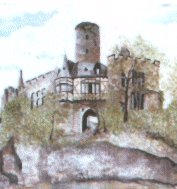 (Bild: Hans Finette) (Bild: Hans Finette) |
|
Just beneath the castle we find St.
Michael´s Chapel (Michaelskapelle). It was built together with the castle in 1210, destroyed with it in 1583, and it was
rebuilt in 1660.Price Elector Josef Clemens von Köln saw to its baroque interior 1697 - 1699; his coat of arms is shown
above the entrance.
|
|
|
When, in 1805, St.Michael´s Chapel became the church of the new Parish of Godesberg, the Old Castle
Cemetery grew around it. |
|
|
During the renovation of the ruins
Franconian burial sites have been found. Already in the 8th and 9th centuries the Franconian people used the site on top of
the hill to bury their dead.
Passing the sepulchre "Mother
Earth" we walk down to the so-called Mausoleum. The domed building in Moorish style was built in 1904/05 and today serves as the
Chapel.
We are about to leave the Castle
Cemetery in the direction of St. Mary´s, today the parish church in Bad Godesberg´s inner city. |
The oldest part of the Castle Cemetery dates back to 1805, and until 1924 the
churchyard was enlarged in the form of terraces. There are many graves of historic personalities of Bad Godesberg.
|
|
|
|
| We now stroll through the so-called"croppers quarter". During the reign of the Prince Electors (i.e. the archbishops of Cologne) you
would have seen there farms and fields and also the Godesberg mineral springs.
|
The clearance and re-development of the old inner city (1988 - 1990) did not
leave much of the appearance of this quarter. Old structures were replaced by new buildings for housing and offices.
|
|
There is, however, still a tap for the
water of the original Draitsch Fountain and of the Prince Elector´s Fountain which had been opened later. |
An old print shows the setting of the Godesberg fountain as it looked at the
time of the Prince Electors. In the background the Godesburg Castle. This fountain later was enlarged by a bath house. In the 1990s the bottling plant for Godesberg
mineral waters was closed down.
|
|
Walking towards the Redoute Park we reach the Schwann House. Because of the re-development of the old inner city this house stood in the
way and was to be torn down forever. Citizens protested and forced the administration to dismantle the house und to rebuild
it, true to the original, 1978/79.
|
|
|
Here we continue towards the Redoute and city hall. |
continue... |
|
|
Return to Start of the tour.<<< zurück |

